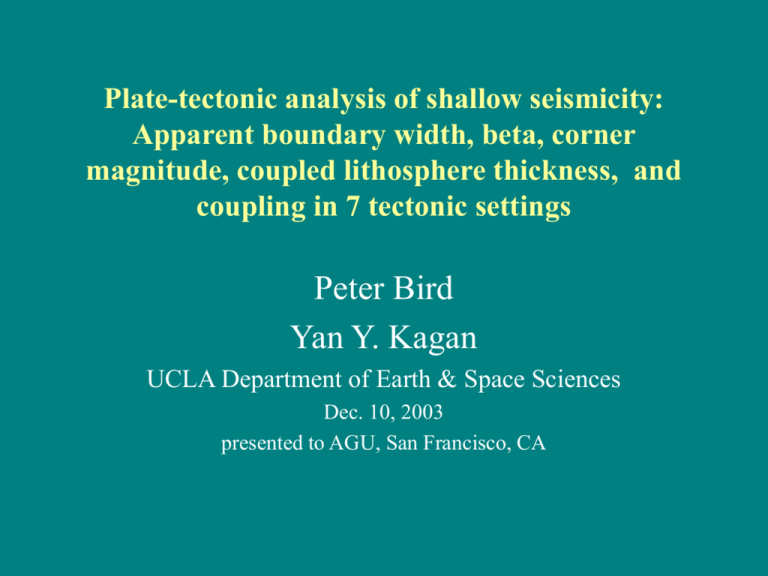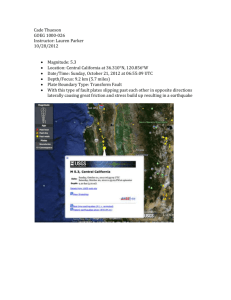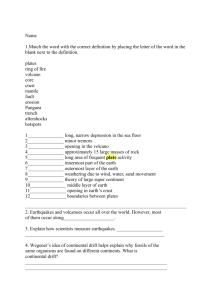*************0
advertisement

Plate-tectonic analysis of shallow seismicity: Apparent boundary width, beta, corner magnitude, coupled lithosphere thickness, and coupling in 7 tectonic settings Peter Bird Yan Y. Kagan UCLA Department of Earth & Space Sciences Dec. 10, 2003 presented to AGU, San Francisco, CA Seismic coupling and frequency/magnitude relations are best determined from global statistics. • Different kinds of plate boundary clearly have different seismicity characteristics. • But, no single subduction zone (etc.) has a long enough seismic record to determine corner magnitude and coupling reliably [McCaffrey, 1997]. • We use the “ergodic assumption”: Global data over one century may substitute for local data covering thousands of years. The kinematic basis for the global calibration: Plate boundary model PB2002 has 52 plates and 13 orogens: Bird [2003] An updated digital model of plate boundaries, Geochemistry Geophysics Geosystems, 4(3), 1027, doi:10.1029/2001GC000252. Every digitization step (from 1-109 km long) along every plate boundary is classified as being one of 7 types: Using the Harvard CMT catalog of 15,015 shallow events: We study histograms of earthquake* frequency as a function of distance to the nearest plate boundary: [*shallow earthquakes of appropriate focal mechanism, excluding those in orogens] Note that the distribution for SUBduction zones is asymmetrical: Formal assignment of an earthquake to a plate boundary step is by a probabilistic algorithm that considers all available information: step type, spatial relations, EQ depth, and focal mechanism: The A factor takes into account the length, velocity, and inherent seismicity of each candidate plate boundary step. The inherent seismicity levels of the 7 types of plate boundary (obtained by iteration of this classification algorithm) are valuable basic information for seismicity forecasts: We allow for several different “model earthquake” focal mechanisms on each plate boundary step. When the step is oblique to relative plate motion (the general case), the Earth may produce either obliqueslip EQs, or sets of partitioned-slip EQs: The final classification factor (E) “grades” a possible match on the angular discrepancy between actual and model focal mechanism: The result… Advantages of this distribution: Simple (only one more parameter than G-R); Has a finite integrated moment (unlike G-R) for b < 1; Fits global subcatalogs slightly better than the gamma distribution. The maximum-likelihood method is used to determine the parameters of these tapered G-R distributions (and their uncertainties): An ideal case (both parameters determined) A typical case (corner magnitude unbounded from above) not to be taken literally! (“a large number”) threshold magnitude 95%-confidence upper limit 95%-confidence lower limit 95%-confidence lower limit Review of results on spectral slope, b: Although there are variations, none is significant with 95%-confidence. Kagan’s [1999] hypothesis of uniform b still stands. In many cases, subcatalogs obtained from the Harvard CMT catalog for non-orogen regions are not large enough to define 95%-confidence upper limits on the corner magnitudes. We next enlarged some of our subcatalogs in three ways: included events of 1976 AD from catalog of Ekström & Nettles [1997] (mt 6.28); included events of 1900-1975 AD from catalog of Pacheco & Sykes [1992] (mt 7.10); included plate-boundary-associated events from within the 13 orogens of PB2002: But, it is necessary to be careful: • Catalog data from 1900-1975 is less accurate in every way (moment/magnitude, location, depth, focal mechanism-?), and therefore these events are more likely to be misclassified. • The high catalog threshold (mt = 7.1) makes b very hard to determine, and risks biasing mc values which are smaller. We chose not to work with merged subcatalogs for OSR and OTF/medium-fast, where we already know that mc < 7.1. We fix b at the value determined from the 1977-2002 Harvard CMT catalog, and only optimize the corner magnitude mc. IMPLICATIONS: 1. Now that we know the coupled thickness of seismogenic lithosphere in each tectonic setting, we can convert surface velocity gradients to seismic moment rates. 2. Now that we know the frequency/magnitude distribution in each tectonic setting, we can convert seismic moment rates to earthquake rate densities at any desired magnitude. Kinematic Model Moment Rates Long-term-average (Poissonian) seismicity maps For SUB steps, the depth PDF function D associated with each “model earthquake” helps to separate mechanisms expected to be shallow (green curve) from those expected to be within the slab (blue curve, for case of slab top at 25 km depth) and those thrust events expected to lie along the slab-top plate interface (a Gaussian PDF centered on this depth; not shown here).






